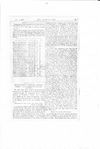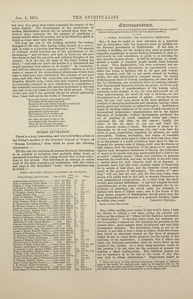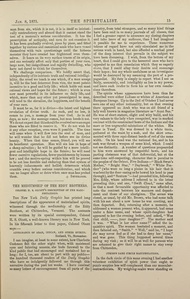Human Levitation
There is a long, interesting, and very well written article in last Friday's number of the Quarterly Journal of Science, on “Human Levitation” from which we quote the following information: –
Till the last two centuries all persons known in Christendom to be subjects of levitation were probably either burnt or canonized, according to the ruling clerical view of their orthodoxy or the reverse. The following is an attempt to collect some of the chief examples not condemned with the volume and page of the Bolandists’ “Acta,” where particulars may be found[2]: –
| Name, Country, and Condition | Date of Life | Acta Sanct. | Vol. | Pages |
|---|---|---|---|---|
| Andrew Salus, Scythian Slave | 880-946 | May | VI | 16* |
| Luke of Soteriam, Greek Monk | 890-946 | Feb. | II | 85 |
| Stephen I, King of Hungary | 978-1038 | Sept. | I | 541 |
| Ladislaus I., Ditto (his grandson) | 1041-1096 | June | V | 318 |
| Christina, Flemish Nun | 1150-1220 | July | V | 656 |
| St. Dominic, Italian Preacher | 1170-1221 | Aug. | I | 405, 573 |
| Lutgard, Belgian Nun | 1182-1246 | June | III | 238 |
| Agnes of Bohemia, Princess | 1205-1281 | March | I | 522 |
| Humiliana of Florence, Widow | 1219-1246 | May | IV | 396 |
| Jutta, Prussian Widow Hermit | 1215-1264 | May | VII | 606 |
| St. Bonaventure, Italian Cardinal | 1221-1274 | July | III | 827 |
| St. Thomas Aquinas, Italian Friar | 1227-1274 | March | I | 670-1 |
| Ambrose Sansedonius, Itln. Priest | 1220-1287 | March | III | 192 |
| Peter Armengol, Spanish Priest | 1238-1304 | Sept. | I | 334 |
| St. Albert, Sicilian Priest | 1240-1306 | Aug. | II | 236 |
| Princess Margaret of Hungary | 1242-1270 | Jan. | II | 904 |
| Robert of Solentum, Italian Abbot | 1273-1341 | July | IV | 503 |
| Agnes of Mt. Politian, Itln. Abbess | 1274-1317 | April | II | 794 |
| Bartholus of Vado, Italian Hermit | 1300 | June | II | 1007 |
| Princess Elizabeth of Hungary | 1297-1338 | May | II | 904 |
| Catharine Columbina, Sp. Abbess | 1387 | July | VII | 352 |
| St. Vincent Ferrer, Sp. Missionary | 1359-1419 | April | I | 497 |
| Coleta of Ghent, Flemish Abbess | 1381-1447 | March | I | 559, 576 |
| Jeremy of Panormo, Sicilian Friar | 1381-1452 | March | I | 297 |
| St. Antonine, Archbp. of Florence | 1389-1459 | May | I | 335 |
| St. Francis of Paola, Missionary | 1440-1507 | April | I | 117 |
| Osanna of Mantua, Italian Nun | 1450-1505 | June | III | 703,705 |
| Bartholomew of Anghiera, Friar | 1510 | March | II | 665 |
| Columba of Rieti, Italian Nun | 1468-1501 | May | V | 332*-4*, 360* |
| Thomas, Archbishop of Valencia | 1487-1555 | Sept. | V | 832, 969 |
| St. Ignatius Loyola, Sp. Soldier | 1491-1556 | July | VII | 432 |
| Peter of Alcantara, Spanish Friar | 1499-1562 | Oct. | VIII | 672, 673, 687 |
| St. Philip Neri, Italian Friar | 1515-1595 | May | VI | 590 |
| Salvator de Horta, Spanish Friar | 1520-1567 | March | II | 379-80 |
| St. Luis Bertrand, Sp. Missionary | 1526-1581 | Oct. | V | 407-483 |
| St. Theresa, Spanish Abbess | 1515-1582 | Oct. | VII | 399 |
| John a Croce, Spanish Priest | 1542-1591 | Oct. | VII | 239 |
| J. B. Piscator, Roman Professor | 1586 | June | IV | 976 |
| Joseph of Cuportino, Italian Friar | 1603-1663 | Sept. | V | 1020-2 |
| Bonaventure of Potenza, Itln. Friar | 1651-1711 | Oct. | XII | 154-157-9 |
The Mediumship of the Eddy Brothers
The New York Daily Graphic has printed long descriptions of the appearance of materialised spirits, witnessed through the mediumship of the Eddy Brothers, at Chittenden, Vermont. The accounts were written by its special correspondent, Colonel H. S. Olcott, a well-known literary man in New York. In his fifteenth letter to that paper, Colonel Olcott says: –
Rutland, Vt., November.
I can imagine, at least to some extent, how Charlotte Cushman felt the other night when, with moistened eyes and faltering accents, she bade farewell to the kind public that had encouraged and sustained her so long; for I, too, am about to part with my public – the hundred thousand readers of the Daily Graphic who have so indulgently followed me through this narrative during the past ten weeks. I have received so many letters of encouragement from all parts of the country, from total strangers, and so many kind things have been said in so many journals of all classes, that I feel a greater regret to announce my closing chapters and take leave of my audience, than I had imagined it possible for me to experience. These numerous tokens of regard have not only stimulated me in the serious work in hand, but also afforded a marked proof of the deep interest that prevails in the subject we have been discussing. I wish, from the bottom of my heart, that I could give to the bereaved ones who have appealed to me that consolation which they so eagerly crave, that I could allay their doubts and encourage their hopes; but my whole usefulness as an investigator would be destroyed by my assuming the part of a propagandist. My duty is simply to report what I see as fairly, accurately, and intelligibly as lies in my power, and leave each reader to form his or her own conclusions therefrom.
The spirits whose appearances have been thus far described were either Indians or whites of American or European lineage. Up to the 2nd of October I had never seen one of any other nationality, but on that evening there appeared an Arab who was an old friend of a lady well known in magazine literature as "Aunt Sue." He was of short stature, slight and wiry build, and his very salaam to the lady when recognised, was in marked contrast with the constrained bows of the Indians and the more or less ungraceful salutations of the whites. His name is Yusef. He was dressed in a white tunic, gathered at the waist by a sash, and the skirt ornamented with three equi-distant bands of red of the same width. On his head was the national fez, and in his sash was thrust a weapon of some kind, which I could not see distinctly. A number of questions propounded to him were answered by respectful bows, and his parting obeisance was of that deferential, but at the same time self-respecting, character that is peculiar to the peoples of the Orient. Five Indians – “Black Swan's Mother,” “Bright Star,” “Daybreak,” “White Feather” (who wore so long and plume in his hair that it was bent by the door-casing as he bowed his head to pass through), and “Santum” – had preceded him, following Mrs. Eddy, whose address I referred to in the letter preceding this; and one, “Swift Cloud,” came after, so that a most favourable opportunity was afforded to note the contrast between his manners and deportment and those of our aborigines. The seance was closed, as usual, by old Mr. Brown, who had some talk with his son about a new house he was creating, and then departed. But, returning after a moment, he addressed a woman present who, it appeared, had come under a false name, and whose spirit-daughter had appeared to her the evening before, and asked, “Was that child, ------, your daughter?” The mother said it was. “What is her other name?” asked the inquisitive spirit. The woman hesitated a moment, and then faltered out, “Smith.” “Well,” said he, “I hope she may never feel as if she had to deny her name,” and was gone. This thing happened several times during my visit; so it will be as well for persons who are ashamed to give their right names to stay away from Chittenden.
In the dark circle of this same evening I had another volunteer exhibition of spirit power that ought to puzzle sceptics less self-complacent than our muscular-contractionists. My weighing-scales were standing on <... >
Editor's notes
- ↑ Human Levitation by unknown author, London Spiritualist, No. 124, January 8, 1875, p. 23
- ↑ The following table is also quoted in the article Yoga Vidya (The Theosophist, vol. 1, No. 4, January, 1880) with more comments.
- ↑ The Mediumship of the Eddy Brothers by Olcott, H. S., London Spiritualist, No. 124, January 8, 1875, pp. 15-8
Sources
-
London Spiritualist, No. 124, January 8, 1875, p. 23
-
London Spiritualist, No. 124, January 8, 1875, pp. 15-8



